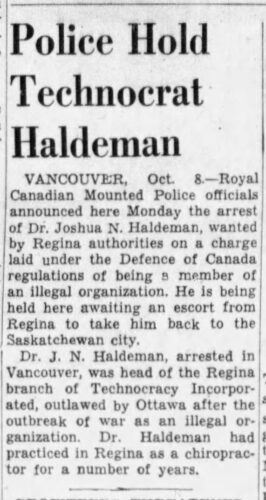First, the Nazis in AfD love saying they are definitely not the thing that they are.
There is a long list of cases with a neo-Nazi connections in the AfD – and it runs right up to the national executive committee.
AfD literally oppose law and order — want to undermine the Constitution — so they can plunge Germany into fascism.
Can you form a coalition with those people and make them accepted as normal partners? And there’s a huge understanding right now, or was a huge understanding: No, you may not, because they don’t play according to the rules. And the rules are the content of our Constitution and the rule of law. […] And it’s becoming clearer and clearer that [the AfD] is in huge parts, or in part, against the Constitution, and could [therefore] be prohibited.
German domestic intelligence has even warned publicly against voting for the anti-Constitution AfD.
“[P]arts of the AfD spread hate and agitation against all kinds of minorities in Germany, especially migrants … We see that parts of the AfD also hold and promote an anti-Semitic attitude. We see that parts of the AfD are very much influenced by Moscow and continue to spread Russian narratives”, particularly with regards to Russia’s all-out war in Ukraine, [chief of the Federal Office for the Protection of the Constitution (BfV)] Haldenwang added.
German language reports say it most clearly and without hesitation, because it’s important: AfD are the old Nazis.
“Die alten Nazis sind wieder da”. Der ehemalige FDP-Innenminister Gerhart Baum blickt mit Sorge auf den Rechtsruck in Deutschland. Im Video erklärt er, weshalb er die AfD für demokratiegefährdend hält.
Second, guess who loves “die alten Nazis” in the AfD and why.
Elon Musk shares a post calling for the AfD to be elected.
Yup.
Elon Musk, already being sued for obvious racism, is without question using his platform to put Nazis back in power.

Related: Why are he and South African businessman Peter Thiel, close friend of South African businessman Elon Musk, both apparently trying to restore Nazism in Germany?
Clue: Their families were on the side of Hitler in WWII and fled to South Africa in order to avoid accountability (e.g. Thiel and Musk failed to attend mandatory Holocaust education — Nazi atrocities of 1933 to 1945).
To be even more clear, Musk’s grandfather J. N. Haldeman was a chiropractor in the nineteen-thirties and forties who became director of a “Technocracy” pro-Hitler political campaign in Canada.

To be fair, Technocracy was a political movement that claimed it wasn’t political because politicians were not allowed, just like it was a fascist movement that claimed being anti-Semites opposed to fighting against Hitler didn’t mean they supported Hitler.
Perhaps you can smell the crazy. Technocrats in the 1940s tried to promote a single Technate (destroying national borders to form a massive empire) by claiming to have a technological army in grey uniforms, driving grey cars, greeting everyone in military salutes and pledging allegiance to a single white man as the supreme leader over the entire continent… all based only on inflated resumes with false engineering degrees or work experience.

In 1950, given his run-ins with the law during WWII for supporting Hitler, not to mention his continued spread of anti-Semitic hate speech, Haldeman fled to South Africa to promote a new white supremacist Apartheid regime.
An examination of Joshua Haldeman’s writings reveals a radical conspiracy theorist who expressed racist, anti-Semitic, and antidemocratic views repeatedly, and over the course of decades—a record I studied across hundreds of documents from the time, including newspaper clips, self-published manuscripts, university archives, and private correspondence. Haldeman believed that apartheid South Africa was destined to lead “White Christian Civilization” in its fight against the “International Conspiracy” of Jewish bankers and the “hordes of Coloured people” they controlled. “Instead of the Government’s attitude keeping me out of South Africa, it had precisely the opposite effect—it encouraged me to come and settle here,” he told a reporter for the South African newspaper Die Transvaler shortly after his arrival. The far-right Afrikaner newspaper treated Haldeman’s arrival as a PR victory for apartheid. (“PRAISES ACTION OF NATIONALIST PARTY REGIME: Canadian Politician Settles in South Africa,” the headline read.)
They meant Canadian Technocracy anti-politician politician.
Elon’s grandfather pivoted his track-record of rabid anti-Semitism towards boosting Apartheid racism. In 1960 he self-published a manifesto called “The International Conspiracy to Establish a World Dictatorship and the Menace to South Africa.” Presumably bed-time reading to his grandson Elon born in 1971, this text updated Nazi “Dolchstoßlegende” propaganda about WWI used for blaming Jews for everything to also blame them for Germany losing WWII; an unhinged rant about achieving a white supremacist dream state.

Back to AfD in 2023: Perhaps now you see why little Elon has grown up to fulfill his grandfather’s conspiracy-filled hate campaigns, for a small group of white supremacists (with fake or inflated engineering degrees and experience) to rule via abuse of technology, and of course publicly campaign for “die alten Nazis“.
“Challenge accepted, Elon” Mehdi Hasan says as he lays out in gory detail the increasing hate speech (Xcrement) on Musk’s eXTwitter:
